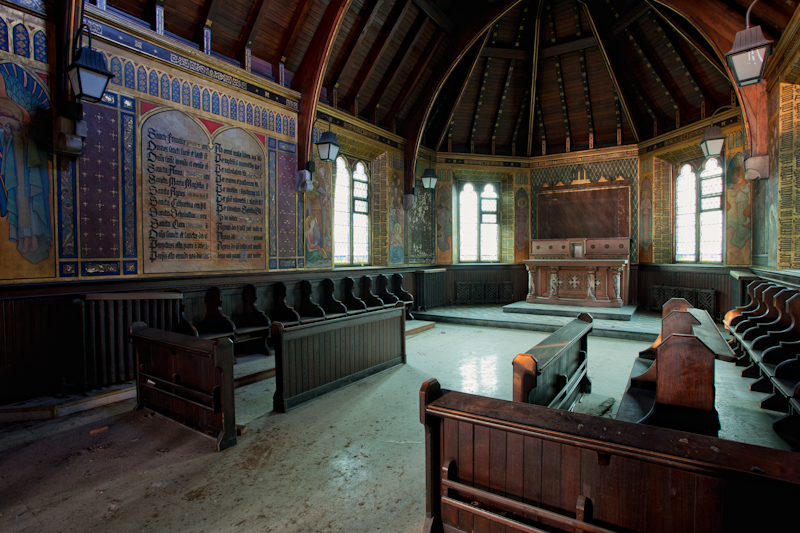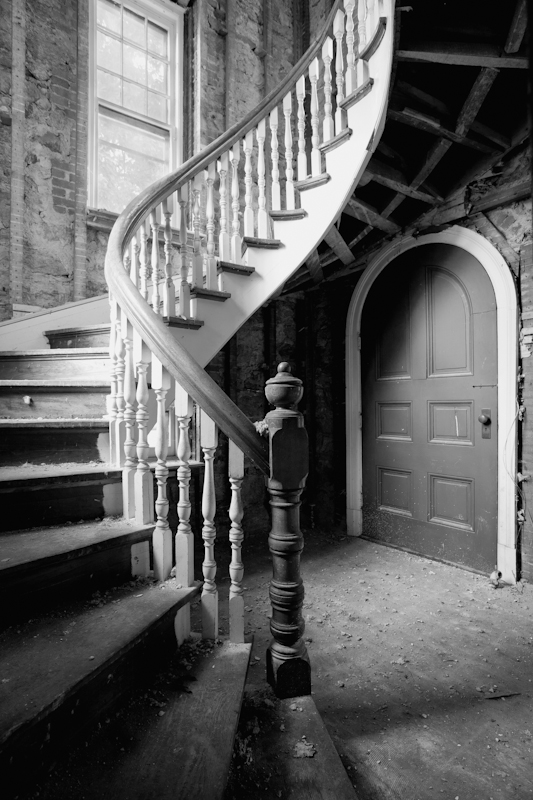Norwich State Hospital's Salmon building once housed the male criminally insane. The design of the ward was such that a number of doors were installed inside the hallway and for one door to be unlocked, the previous door must be closed and locked. This helped to ensure that during the 70 years of operation, not a single patient escaped from this ward.
Photo: "Seaside Sanatorium"
Doctor and nurses quarters.
The Seaside Sanatorium in Waterford, Connecticut opened in 1930 as a tuberculosis hospital for children. The location was chosen based on the thought that the fresh air of the Long Island Sound would help ail the suffering children. In 1958, the hospital began treating the elderly who were mentally handicapped. In the 1970's, there was evidence that those hospitalized at Seaside were being abused by the staff causing a higher death rate among the patients. Due to those allegations, the hospital closed in 1996.
Photo: "Missing"
The Stribling building at Norwich State Hospital was constructed in 1911 and once housed the physically violent males of the campus.
Photo: "End of the Line"
Hallway inside the male wards.
In 2007, four years after Hudson River State Hospital closed, a lightning strike transformed the male ward wing of this Kirkbride into a raging fire, destroying most of this section. Over the last few years, the New York weather has slowly escalated the damage inside the ward. Despite the decrepit state of the hospital, the main administration building has been registered as a National Landmark due to the High Victorian Gothic architecture.
Photo: "Viola"
Collapsing second foor of the male wards at Hudson State Hospital.
Photo: "Synchronicity"
The diffused setting sun lights the Brigham building at Norwich State Hospital in Connecticut.
U.S.S. Iowa BB-61: Benicia to Richmond
On Thursday October 27, 2011, USS Iowa was removed from the Suisun Bay Mothball Fleet and placed at the Port of Benicia, where she spent one night before beign transferred to Richmond. For the next three months, USS Iowa will undergo significant refurbishment before making the long journey to Berth 87 in Los Angeles where she will become an interactive museum.
The battle this ship has experienced since her decomissioning was politically based and spanned across the past ten years as she sat in Suisun Bay. There was always a push to turn the battleship into a museum in San Francisco, but the Board of Supervisors was against mooring a miliitary ship based on a "homophobic entity" within the confines of the city, which caused other organizations to raise money in the hopes to move the ship to another California dock.
USS Iowa is the last of four remaining battleships of its kind and the last of the four to be turned into a museum. The 887 foot long USS Iowa, built in 1940, was the fastest ship in her class of battleship and the only ship of her class to have served in the Atlantic Ocean during World War II. Her main battery consisted of nine 16"/50 Caliber Mark 7 guns which could fire 2,700lb shells approximately 20 miles.
In 1989, during a gunnery excersise, an explosion occurred in the center gun room destroying Turret #2 and killing 47 sailors.
The ship was decomissioned in 1990 and placed in the Suisun Bay Reserve Fleet short thereafter.
Port of Benicia
Leaving the Port of Benicia
Approaching the Carquinez Bridge
USS Iowa after passing under the Richmond Bridge
Nearing Berth 3 in Richmond
Tugboat pushes USS Iowa towards the pier
Aft guns
Arriving at Berth 3 in Richmond
Flying the US Flag in Richmond
Forward 16"/50 caliber Mark 7 guns
Portside guns, 5"/38 caliber twin turrets
Securing the mooring lines
Crew
Crew
WWII Veteran Joe served aboard USS Iowa during her first deployment in 1942.
Photo: "Rockweed"
Decayed bathroom inside Norwich State Hospital's Salmon Building, designed for the male criminally insane.
Photo: "Seaweed"
Patient tub inside a patient treatment building, Canaan Hall, at a Connecticut Hospital.
Photo: "Chapel"
The second floor chapel inside the Abbey building of the St. Mary's Convent on Mount St. Gabriel in Peekskill, New York provided services for the ailing nuns residing within the Abbey.
Photo: "Diamond Light"
Sunset inside Norwalk Hall, employee housing, at a Connecticut State Hospital. The hospital was in operation from 1931 to 1995 and once housed 4,000 patients, 20 doctors and 50 nurses.
Photo: "One Star"
Galt Building at Norwich State Hospital, a former psychiatric hospital in Preston, Connecticut.
Photo: "Tub"
The Canaan House at an East Coast State Hospital, was used for patient treatment and housing.
Photo: "O2"
Looking out onto a porch inside the Bell building, patient building, at Norwich State Hospital, a former psychiatric hospital in Preston, Connecticut.
Photo: "Spun"
Spiral staircase leading from first floor to third floor inside the 1876 Abbey of the Community of St. Mary in Peekskill, New York.






























